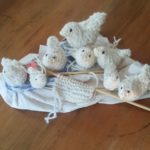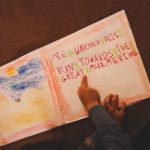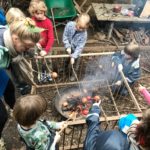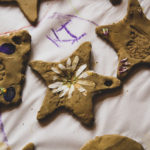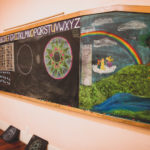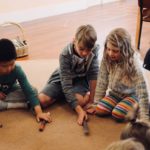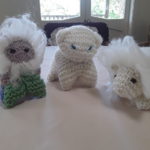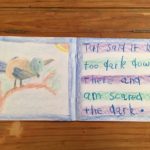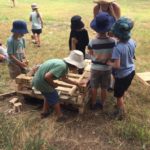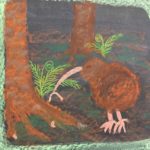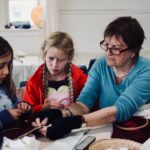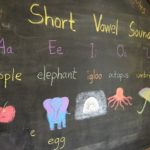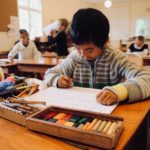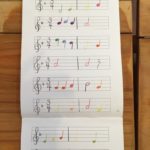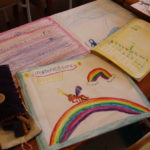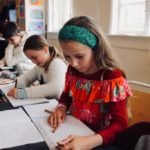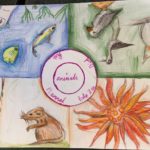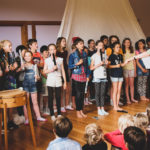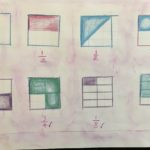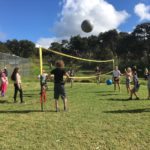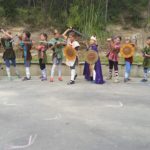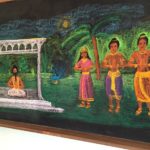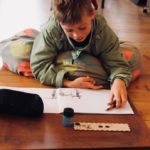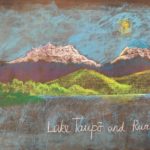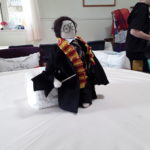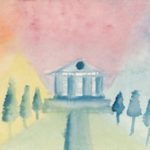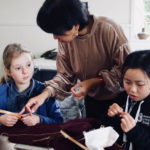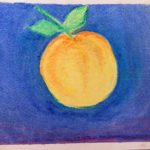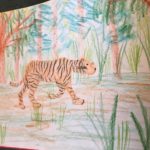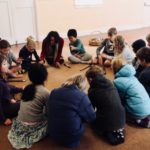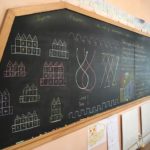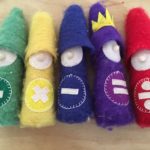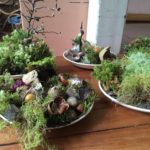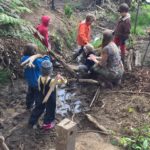Children start formal schooling (Class 1) in the year they turn seven. The education is rich and creative, filled with stories, music, games and art.
In the second seven years of life our young people develop and are educated through their feelings. Waldorf teachers teach as loving authority figures, delivering a curriculum that stimulates a rich feeling life full of experience with special focus on the appreciation of beauty and the ideal.
Each subject is approached artistically and age appropriately, laying a foundation for well-rounded children with enquiring minds, an enthusiasm for learning, and a readiness for the intellectual learning ahead.
Screens are not used in the Lower School. Our education focuses on creating resilient kids who value working together, who have good relationship skills and don’t rely on digital devices for satisfaction.
- Classes 1-5, with children aged 6-11
- They start with a teacher who will stay with them throughout their Lower School journey
- Class size is usually up to 25 students
- Minimal assessment or testing
- Te Reo and Te Ao Māori are integrated throughout the curriculum in each class
- The curriculum is broad and deep, and taught in a unique, rich way that delivers a full, well-rounded education.
To view our latest Education Review Office (ERO) Report please click here
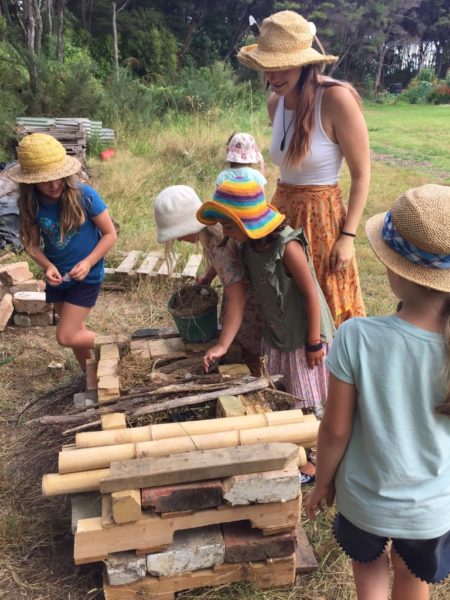
Class One - “I am”
- The child starts Class One in the year they turn seven.
- The theme of the year is fairy tales.
- The children of Class One are encouraged to live within the stories and images of fairy tales and nature stories to foster their creativity and support their inner development.
- All subjects are taught in an integrated and artistic way that draws on the imagination of the six and seven year old.
In Class One the aim is to form a cohesive and socially harmonious class. Throughout the year the teacher establishes good classroom, life and work habits, creating healthy rhythms and boundaries that support the children in their daily life. The children are encouraged to care for one another like family and take ownership of good habits.
The aim is not to learn to write and read as quickly as possible, but to create rich experiences that stimulate the child’s senses and nurture their thinking, feeling and motivation.
Development is dreamy and earthy. Not yet fully aware of themselves as separate individuals, the child relates to the world as it affects them. They wish to know that the world is beautiful, that adults know what is right and good and will look after their needs. Children of this age can love easily and will wish to please those they love.
What is part of Class 1 curriculum?
The Alphabet & Letters
The children learn from the experience of the image to the form, the letter. The imagination is encouraged to provide the bridge from stories to the letters. In this way, the child learns the alphabet by drawing pictures from the fairy tale or story of the day. The golden goose becomes a G, the king becomes a K.
The children have a strong experience of each letter. They learn to correctly draw them using chalk boards, walking the letters drawn big on the ground, drawing in the air, in sand or on each other’s backs. They play games with the sounds, finding words with the sounds at the start or end, and use poems and rhymes for different letters and their sounds.
They progressively learn to write words and sentences from the stories they are hearing and the pictures they are creating. Reading is then introduced as a whole class activity. Together they phonetically sound out words and read what they have written together as a whole. The main lesson books they make become their readers, and as they became more familiar with the writing in them they begin to read them to each other.
Mathematics & Numbers
The magical world of numbers, counting and basic maths are introduced through rhythm, stories, games and movement. The children begin to experience the patterns of numbers in the natural world, and through rhythm, movement and music. This initiates in the child the beginning of a connection to the wider environment.
The children form a relationship with each number, creating a deeper understanding of the quality of each number. For instance, “1” may be taught in relation to the sun, there is only one sun, feeling the wholeness of that one and then looking at themselves as something else there is only one of.
Te Reo & Te Ao Māori
Te Reo and Te Ao Māori are integrated throughout the curriculum. In Class 1 number stories, numbers and waiata are introduced. Forms such as the koru may be explored in form drawing.
Handwork
In Class One, the children learn to knit. They begin to anticipate the joy of creating things both useful and beautiful.
The hand and eye working together opens up neurological pathways. Knitting is a training ground for thinking which later supports them to be able to bring their own thoughts into a coherent whole.
Their first creation brings expressions of delight and joy and a feeling of success and confidence that leads to a love for doing, a love for creating.
Form Drawing
Form drawing starts in Class One with children learning to draw and distinguish between a straight line and a curve. The children are guided to create forms through visualising, moving and drawing the forms. To be able to start and stop a line helps children to sense the boundaries of their own space and form. The forms develop fine motor skills, balance and self movement along with an increased sense of body geography.
Ngahere – the School’s native bush wonderland
Regular visits to Ngahere and nature walks around the school grounds help Class One cultivate reverence for nature, care for the environment, and interest in the world and respect for one another.
They may cut and gather firewood together, prepare and cook kai together, hear nature stories and walk through the bush listening for birds together. Being at Ngahere does something magical to the class, they play and work together in the most harmonious and creative ways.
The Arts
The arts are part of every lesson. The students are being taught though example that everyone can be an artist and that beauty is all around us. Music, including singing and playing recorder, is introduced and the class will have the experience of presenting a play for the families, with all children playing an equal part.
Through guided and continual movement the young children will ‘dance’ through their school day and should arrive at the end of it, not with a feeling of exhaustion, but rather a pleasant feeling of work well done and anticipation of the activities to come tomorrow.
Class Two - “I am - You are”
- The child starts Class Two in the year they turn eight.
- The theme of the year is the lives and deeds of the Saints coupled with animal stories such as Aesop’s Fables.
- The children of Class two are encouraged to live within the stories and images of the Saints and the animals to foster their creativity and support their inner development.
- All subjects are taught in an integrated and artistic way that draws on the imagination of the seven and eight year old.
In Class Two, the children are less dreamy. They can concentrate for longer periods. They are moving towards an awareness of others as different identities with their own needs and abilities. Language and literacy are developed through the creative arts and movement such as drawing, drama, music and eurythmy.
What is part of Class 2 curriculum?
English
A joy in language as the expression and communication of a rich variety of human experience and feeling is experienced. There is a rich language environment in the classroom where stories, verses, rhymes, songs, poetry, tongue twisters and riddles nourish the growing love of expressive language and literature.
The stories of Class Two support the healthy development of a strong moral life within the students. Being encouraged to live with these stories allows the children to experience the higher side of being and acts as a counter-balance to the realities of everyday life. The teacher encourages deeds which show respect and reverence for the world of nature and other people. Writing, reading and artistic skills are practised within the context of these lessons.
Mathematics
In Mathematics, rhythm and recitation in wonderful interweaving number patterns and times tables are practised each day as well as drawn and coloured. The children are captivated by the magical quality of numbers. The children are able to identify, sequence and engage in the number processes and see relationships between sequences. They also see the relationship between addition and subtraction and begin to look at practical strategies.
Science & Geography
Through play, bushwalks and stories the beauty of nature is made more visible to the child and its secrets are slowly revealed.
The children are able to recall clearly, create their own story summaries together and illustrate the world of nature they have encountered.
The quiet mood of observation, the careful interaction and the joyful gratitude for nature are modelled by the teacher and in the deeds of the heroes of the stories.
Human interaction with nature is highlighted through stories of individuals with reverence for and connection with nature such as St Francis.
Te Reo & Te Ao Māori
Te Reo and Te Ao Māori are integrated throughout the curriculum. In Class 2 stories of native birds are enjoyed and explored through art. Vocabulary and waiata expand from Class 1.
Form drawing
Form drawing continues, developing the student’s inner relationship with form and colour and enhancing the inner development of balance. More complex forms are introduced in a playful manner so that the children engage with the process willingly and artistically.
Handwork
In Class two, the children continue to progress their skills in knitting. They develop skills in following patterns, casting on (adding) and casting off (subtracting) stitches. By the end of the year, the children are sewing their own knitting into new animal friends. The children benefit from the gentle and social activity. They are delighted, clapping and congratulating each other, when an animal appears that has taken much time and effort.
The Arts
The arts are part of every lesson. The students are being taught though example that everyone can be an artist and that beauty is all around us. Movement, music and speech are included as part of every day’s activities and drawing and painting are continuously developed in harmony with the child’s inner growth. All students will experience playing a part through the process of learning a play.
Children engage in the full range of all of the creative and performing arts. The world is experienced through touch, smell, taste, hearing and sight as well as the inner experiences while listening to the stories of the world.
Class Three - “I am - Who are you?”
- The child starts Class Three in the year they turn nine.
- The themes of the year are the stories of the Old Testament and the practical activities of farming, gardening and house building.
- All subjects are taught in an integrated and artistic way that draws on the developmental stages of the eight and nine year old.
During the Class 3 year, children turning nine experience something of a ‘crisis’, a turning point or threshold experience that precipitates a greater awareness of their sense of individuality. They no longer experience themselves at one with the world. This is felt as both a loss, causing anxiety and insecurity, and cause for a new self-confidence. It is both exciting and scary. They will push boundaries, become critical, adventure forth fearlessly when you wish they wouldn’t, and later shrivel up fearfully where once they were confident.
In the curriculum this transition is met by a more practical engagement with the world around the child and the child’s place in the world. The Old Testament narratives relating to their trials and tribulations parallel the child’s experiences. Through working together on building and farming projects the sense of separation from the world is replaced by a sense of connection to the environment and community and a feeling of responsibility and confidence.
This moment provides an opportunity to introduce the great themes of humanity: creation, tradition, authority and how they impact on the burgeoning individuality. These themes have been expressed in some of the great narratives of ancient human cultures, and these stories are valuable narratives for the child to experience and to explore at this particular age. The narratives are treated as oral and written literature, great stories, as myths from classical traditions that speak to the growing child’s imagination: they are not treated as statements of fact or faith.
What is part of Class 3 curriculum?
English
In telling the Old Testament stories about creation – the expulsion of Adam and Eve from Paradise; the dispute between Cain and Abel; the trial of Abraham; the role of Moses in leading the ‘chosen people’ out of Egypt – the teacher’s presentation provides archetypal motifs that echo in the child’s soul experiences at this age. They are not taught as myths nor as religious instruction and are complemented with stories of Maori, Polynesian and Asian origin, acknowledging Aotearoa’s location on the Pacific rim. There is a strong focus on reading which follows naturally from speaking and writing.
Mathematics
The world of mathematics assists the nine-year-old in taking hold of the environment and learning to understand it. The historical perspective of the Old Testament stories gives the students a basis out of which to develop the modern use of measurement and money. Learning through doing, measuring, weighing, counting, adding and subtracting, multiplying and dividing are all applied to everyday tasks, needs and queries and spill over into the house-building, farming and gardening activities.
Geography, Science, History, Farming and Gardening
At a time when the children are beginning to feel separated from the world, they need to experience the deep interconnections between all realms of life and develop
an awareness of the seasons.
Through direct contact with the earth through gardening, they can develop a reverence for the kingdoms of nature, their interdependence and the gifts of the earth, its soils, rivers and rain. Through caring for the soil, planting and nurturing the growth of seedlings they can develop a sense of wonder for the plant kingdom that provides us with food and materials for clothing and shelter.
A visit to a farm brings a more concrete appreciation of the role that animals play in providing milk and wool – and dung. The school’s beehives also show how the bees provide us with honey and are essential to the life of a garden as part of a finely balanced web of life – something that will be studied later in the Class 5 Botany main lesson.
The understanding of human stewardship evolves, not conceptually at this age, but through joyful experience and gratitude. As a direct result of these activities the children can be engaged in growing grains, making bread, and butter, and spinning wool. These activities will now be more consciously experienced as part of the work which the children can do. They also construct a shelter of some sort during the year, as part of the ‘housebuilding’ main lesson, in which they look at various forms of dwelling developed by humans in different parts of the world.
Te Reo & Te Ao Māori
Te Reo and Te Ao Māori are integrated throughout the curriculum. A particular subject may be chosen to delve more deeply into stories and vocabulary.
Form drawing
Form drawing continues and students move into a series of more complex forms combining symmetry, circle, expansion and contraction. Form drawing has the ability to focus the child, strengthen spatial awareness and aid in hand-eye co-ordination.
Handwork
A theme of Class Three is house building and weighing and measuring and this may be supported in handwork through “building” a house for one’s recorder and a handwork bag to hold their knitting bags of classes one and two. The process involves learning new stitches and knots and patiently working through a process. Student’s learn the satisfaction of creating something both beautiful and practical from scratch.
The Arts
The arts are part of every lesson. The students are being taught though example that everyone can be an artist and that beauty is all around us. Movement, music and speech are included as part of every day’s activities and drawing and painting are continuously developed in harmony with the child’s inner growth. All students will experience playing a part through the process of learning a play.
At a time when the children are beginning to feel separated from the world they need to experience the deep interconnections between all realms of life.
Class Four - “Who I am - Where I am”
- The child starts Class Four in the year they turn ten.
- The themes of the year are Norse mythology along with Māori mythology, local history and geography and the animal kingdom.
- All subjects are taught in an integrated and artistic way that draws on the developmental stages of the nine and ten year old.
Around the age of 10 a confidence can be observed in the child’s relationship with the world. After the existential sense of separation around their 9th year has passed, the child confronts the world as a more confident self, experiencing a newly established relationship with the surrounding world. Physical development brings a new strength and agility.
What is part of Class 4 curriculum?
English
This new confidence is met with a year-long theme of the myths of Northern Europe: the stories told by the Vikings and other northern peoples express a robust and resilient confidence in the face of overwhelming challenges. These stories, so influential in European culture, are supplemented by narratives expressing similar motifs represented in Māori culture. Poems and verses relating to the content of the local geography and history main lesson as well as the animal kingdom are important.
Ragnarok, the last battle which ushers in the new world of the current time, is also a metaphor for the coming end of childhood, the final glimpse of the magical world of unity that pervades the child’s first experience of life. Through these stories the growing individual is being prepared to enter into the world of adult rationality with a healthy foundation of confidence and strength.
Grammar and creative writing skills are developed within the context of these stories and the aim of the students finding and expressing their place in the world.
In Class 4, students learn the art of fluent handwriting and calligraphy which builds an ability for calm focus and inner as well as outer balance and harmony of form.
Mathematics
In mathematics the children encompass the pictorial and concrete world of fractions – the whole number is broken apart just as they have lost the wholeness of earlier childhood. They can explore long multiplication and division as they stand on the boundary between the pictorial representation and the technical procedures of the later years.
The children’s previous skills with measurement are now fully applied to a larger area as the learn the art of mapping. The ability to take a bird’s eye view emerges and they develop a sense of scale, direction and features by grid reference.
Science, Geography and Local History
Children map the local area and its landscape, flora and fauna, starting from their immediate surroundings.
The ability to take a bird’s eye view is built up from walks and drawn pictures of the local environment and the story form of the flight of the bird. The transposition to this perspective from a height, while imaginative in process, is also objective and precise in form. It is the beginning of the coming into a more aware sense of space.
Through such activity children wake up to the presence of their environment. They no longer live unconsciously in it but connect with it more consciously. Always working outwards from the familiar gives them a strong sense of security and develops the ability to integrate their experience.
Teachers seek to create a feeling of gratitude for those who went before and an awareness of how events that occurred in the past laid the groundwork for the modern environment. Through myths, legends, stories and historical records the local history can be investigated. The children can also undertake their own personal research to look into their family tree. In doing this they enrich their own personal biography and strengthen their feeling for who they are.
Te Reo and Te Ao Māori
Te Reo and Te Ao Māori are integrated throughout the curriculum. In Class 4, local geography provides a rich topic for local Māori stories, as do bird and animal stories.
Form drawing
Form drawing continues to be integrating and strengthening. Increasingly complex patterns may be explored, especially those derived from the Nordic myths.
Handwork
In Class Four students take up the task of cross stitch – one stitch at a time. The magic of turning over the work to see that whilst there are crosses on one side there were curves on the reverse is an exciting moment. Some find the handwork easy and very much to their liking; others enjoy the social ambience perhaps more than the diligence and attention required, and some find the activity quite a challenge.
The Arts
The arts are part of every lesson. The students are being taught though example that everyone can be an artist and that beauty is all around us. Movement, music and speech are included as part of every day’s activities and drawing and painting are continuously developed in harmony with the child’s inner growth. All students will experience playing a part through the process of learning a play.
Camp
Class Four experiences an off-site camp for the first time at our local and magnificent Whatipū beach. Camps are always integrated into the curriculum and the Whatipū camp connects with the local geography and local history themes of Class Four.
The children find their way into the space round them more consciously. The children form a sense of where they are in relation to their environment, both in a social and geographical sense.
Class Five - “Where I stand in the world”
- The child starts Class Five in the year they turn eleven.
- The themes of the year are ancient cultures including India, Persia and Egypt with a particular focus on ancient Greece, along with botany, decimals and geometry.
- A highlight of this year is the “Olympic Games” where all Class 5 students from the North Island’s eight Steiner Waldorf schools come together for a week camp and compete in real “Olympic games”.
- All subjects are taught in an integrated and artistic way that are aligned with the developmental stages of the ten and eleven year old.
Children turning 11 can feel more at ease within themselves. Moving forward with the confidence to meet the world out of their individuality, the children can now freely chose to connect to the other through empathy. A depth of feeling can be noticed and a sense of personal responsibility, of moral compass. The Class Five year is often referred to as the ‘golden age’ of childhood.
In Class Five, the narrative element is joined by more observation, excursions, camps and teacher-guided reading as learning experiences. Recall is not just story based but focuses space and time in maps, diaries and observations. The child’s own work may begin to include change of perspective and extension of scope e.g. a diary entry from the point of view of an ancient Egyptian or Greek.
What is part of Class 5 curriculum?
English
Try to let the children practise distinguishing between telling their own opinion and reporting the opinion of someone else. Then do the same in writing; let the children make a clear distinction between what they themselves think or have seen and what they have heard another person say.
Rudolf Steiner Three Lectures on the Curriculum 6th September 1919
Class 5 continues to develop the child’s social awareness and skills through discovering the interplay between written language and real life. The children enhance and develop the ability to see things from another’s point of view without prejudice or judgement.
The children’s ability to express themselves with skill, clarity and truth is the foundation for later honesty and power of voice.
Botany
While the animal study of the year before has brought awareness of specialisation and one-sidedness; the plant study in Class 5 brings experience of upward striving, connection to the sun, balance, fruition and the miracle of the seed before a spring rebirth. The cycle of the development of seed, root, stem, leaf, bud, flower and fruit – which contains the seed for the next cycle – gives a living picture of organic nature and its connection with the cosmos.
This lesson will deepen the interest in gardening which all students are involved in from Class Three.
Mathematics
The students become increasingly competent in mathematical skills and independent of pictorial representation. They solve problems, choose strategies and work with decimals, discovering how the metric system makes working with fractions more manageable. In geometry they are able to complete complex constructions and begin to work with instruments.
The children have a desire to be challenged and to improve their skills. They consolidate earlier learning and are conscious of wanting to reach a level of proficiency. Decimals set the stage for work with percentages in Class Six.
History
In this year the curriculum traces the shift from mythology to history. The cultures of the great civilisations of Ancient India, Persia, Mesopotamia, Egypt and Greece are explored with an emphasis on the social, cultural and spiritual aspects of the civilisation’s development and their time of greatest influence. The leaders of these ancient cultures were often religious figures and religious belief played a significant part in defining the social order up until the development of democratic government in Ancient Greece.
These main lessons reveal the development of human consciousness over time and the gradual emergence of a new sense of individuality and intellectual prowess, something that the children can relate to the development of their own lives, and growing minds.
Geography
In Class 5, the study of Geography aims to lead the children into a deeper relationship with the world, fostering a feeling for, and understanding of, their own land. Having made themselves at home through the study of their local region in Class 4, they now range further afield and explore the geographical features of the whole of Aotearoa New Zealand.
Te Reo and Te Ao Māori
Te Reo and Te Ao Māori are integrated throughout the curriculum. Some subjects will be chosen to delve more deeply. In Class 5, the study of New Zealand geography, and the journey from the mountains to the sea, provides a wonderful opportunity to learn Te Reo vocabulary and to hear Maori stories and legends.
Handwork
Class Five is a time for heroes and heroines in handwork lessons. Dolls are made bringing a sense of imagination and form to the human being. Each child is asked to choose a personality from their main lesson. This project involves working with fabric and creating the dolls from limbs, to facial features, to its final costume.
The Arts
The arts are part of every lesson. The children are being taught though example that everyone can be an artist and that beauty is all around us. Movement, music and speech are included as part of every day’s activities and drawing and painting are continuously developed in harmony with the child’s inner growth. All children will experience playing a part through the process of learning a play.
Camp
A highlight of this year is the “Olympic Games” where all Class 5 students from the North Island’s eight Steiner Waldorf schools come together for a week-long camp and compete in real “Olympic games”.
Specialty subjects
Visual arts
Visual arts are integrated throughout the curriculum. The aim is to develop the artist within each child. We teach not just artistic skill, but all subjects are taught artistically. Throughout the lower and middle school years the visual arts are developed from simple watercolour painting to working with perspective through colour, beeswax modelling, and clay sculpting.
Music
Music is integrated throughout the curriculum. Developing the musician’s ear, is as important as learning to play music. Recorders and tuned percussion, as well as singing, are introduced from Class 1. In Class 3 music notation is introduced. Classes may join together to form a choir or musical ensemble for assemblies and festivals.
Woodwork
We have a wonderful woodwork studio in which students learn practical skills and the joy of creating beautiful objects from scratch.
Drama
Each class presents a play each year, with all children participating in a variety of roles over time to challenge them and widen their perspective of others.
Eurythmy
Eurythmy is taught throughout the lower school school. Eurythmy builds spatial awareness in children and an expressive connection to their spirits. The eurythmy teacher calls the children to grace and beautiful movement through exercises, patterns and games with increasing complexity as the children grow. Students learn to comprehend their own movement in a disciplined way over time, and also the movements of others and the need for space to be maintained thoughtfully between people, not only for oneself. Eurythmy makes for intelligent feet and hands that inform an intelligent head and a thinking heart.
Handwork
Handwork develops from basic knitting, crochet and sewing to producing challenging and complicated handwork items. Handwork is more than making things, it can lay the foundation for work, give the children a sense of pride and a feeling of success; it can support the development of a sustained will and being able to apply oneself to complete a task. It can strengthen their life forces through applying thought and effort in making something which they have enthusiasm and joy in making. Through learning new skills their capacity to concentrate and focus is strengthened. Through following instructions, written and verbal, their comprehension of the word is supported. It gives the students experience of making whatever they choose to do into a practical reality.
Learn more about the value of knitting
To view our latest Education Review Office (ERO) Report please click here
The rhythm of the day
Morning circle
The day begins with a Morning Circle, an “in-breath” starting with a verse. Then games, songs, stamping rhythms and other movement activities follow, challenging the children to work together as well as having some fun! The Morning Circle practises many skills and brings the children into the rhythm of the day and a readiness to learn.
Main lesson
The main academic subjects are taught in the first two hours every morning for a period of three to four weeks. In this way the students are able to live deeply into a subject. Subjects are approached in an integrated and artistic way. The rhythm of this approach, the development, and depth of content gives the children a rich learning experience. The Main Lesson incorporates subjects such as English, Mathematics, History, Geography and Science and Technology. Students create their own beautiful Main Lesson books rather than learning from textbooks. Within the rhythm of the day, this is considered to be the ‘thinking’ part of the day.
Encouraging and allowing children to learn experientially, avoiding sitting them down and feeding them facts, lies at the heart of every Waldorf teacher’s intent.
Practice lessons
After morning tea, during the Practice Lessons, students consolidate their Main Lesson learning, practise literacy and numeracy skills and participate in art, music, language and movement activities. Within the rhythm of class day, this is considered to be the “feeling” part of the day.
Afternoon lessons
The afternoon lessons are the ‘willing’ or doing part of the day. Children take part in games and sports as well as participating in a range of creative and practical activities such as gardening and cooking.
Specialist teaching periods
Students learn from specialist teachers in areas such as handwork, eurythmy, bothmer gym, languages, music, and art. Students in Classes 6 – 8 have woodwork lessons and physical education classes.
Festivals
Easter, Autumn, Mid-winter, Matariki, Spring, and Advent Festivals are celebrated throughout the year. In the week leading up to the festival students are led to a relationship with the event and the season through appropriate activities, stories, songs and verse. The festivals are celebrated annually allowing the students to build up a body of knowledge and enhancing their experience over time.
The children are encouraged to experience respect and reverence for the earth and life as a whole, through a rhythmical celebration of seasonal and traditional festivals throughout the course of the year. These festival days are celebrations which bring the whole community together and offer an opportunity for the teachers and children to engage in drama, artistic presentations, crafts and singing. This rhythmical celebration of seasonal and traditional festivals encourages the children to experience respect and reverence for the earth and life as a whole.




